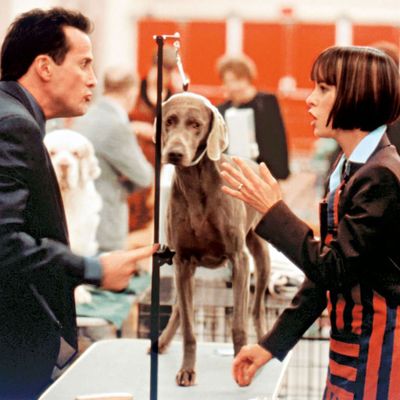
Every week for the foreseeable future, Vulture will be selecting one film to watch as part of our Friday Night Movie Club. This week’s selection comes from news writer Rebecca Alter, who will begin her screening of Best in Show on August 28 at 7 p.m. ET. Head to Vulture’s Twitter to catch her live commentary, and look ahead at next week’s movie here.
Here are things that I love so much, in no order at all:
• Sorting things into rigid categories spun whole cloth from a web of bullshit so as to compartmentalize them into easy, identifiable tropes (see: Myers-Briggs, Hogwarts houses)
• Sports that ain’t sports
• “Event viewing” and/or awards shows
• Patently goofy traditions treated with the utmost ceremonial importance (see also: awards shows)
• Dumpy pantsuits and sensible flats
• Jennifer Coolidge
• DOGS
I love every dog I see from pupper-A to pupper-Z. And in keeping with all of the aforementioned, I love dog shows. There is an often overlooked aspect of dog shows that is Werner Herzogian in its defiance: They are pageants to show off the triumph of man over nature, and maybe even over God herself. In Best in Show, when Cookie and Gerry Fleck (Catherine O’Hara and Eugene Levy) sing “God Loves a Terrier,” they miss a crucial detail: It was humans — ridiculous, ingenious, silly humans — who decided to take a wolf and refine it to look and behave like everything from a mop (Bergamasco) to an egg (miniature bull terrier) to a Haim sister (Afghan hound). What a wacky, unthinkable task. What mundanely mad science. What a way for the creepiest type of rich white people to channel their evil tendency toward literal eugenics into just making weird, pretty dogs that prance around in circles for ribbons. What a concept.
So of course the absolutely ridiculous world of competitive purebred-dog fanciers was fertile ground for Christopher Guest’s follow-up to Waiting for Guffman. Although mockumentaries are a dime-a-duhzillion in 2020, they were rarer 20 years ago, with the micro-genre’s unique satirical benefits not yet neutered by decades of overkill. Guest was the king (or rather, the literal baron) of the form, assembling one of the most legendary troupes of skilled improvisers to skewer strange subcultures of American life. To get you into the headspace of audiences at the time when Guest and his company of players made Best in Show in 2000, take this passage from the film’s review in the New York Times:
The humor of Mr. Guest and his cast emanates from the post-collegiate baby boomer belief in an elite ”hipoisie” who, unlike everyone else, know what’s cool and what’s not. And dog show habitues, small-town Midwestern chamber of commerce boosters and even successful second-level rock groups are definitely not cool.
And, sure, there was a definite veneer of in-on-the-joke cool to Guest’s alternative comedies at the time; as an antidote to the late-’90s glut of bloated big-budget studio stuff, here was a downbeat, bookish affair, without a soundtrack, mocking its characters and its milieu. Here’s John Michael Higgins, playing one half of a Birdcage-broad gay couple, fretting over how many kimonos to pack for a 48-hour trip. Here’s Parker Posey, Party Girl herself, lampooning frigid yuppies, deadpanning about iMacs and Starbucks and J.Crew through adult braces and the most severe wig ever committed to screen. Guest’s cast is brilliant at playing characters who hold certain delusions about themselves, with his films’ humor coming from the gap between their self-image and what the audience sees. Best in Show adds the additional layer of these people projecting their narratives about themselves onto their dogs: Meg and Hamilton Swan (Parker Posey and Michael Hitchcock) are overbearing helicopter parents to their anxious Sporting Group Weimaraner. The Flecks, with their plucky Norwich terrier, are the film’s literal underdogs. But there’s a heart to Guest’s movies, and Best in Show literally wears it on its sleeve.
Part of that comes from the joy of seeing improvisers getting to follow their comedic instincts within Guest’s sandbox, in which he provides them with scene outlines and character descriptions and lets them loose. In Best in Show, every actor has an all-out moment with their character, primarily because they all have brilliant straight men in their canine scene partners. In a scene like the Busy Bee freakout or Guest’s own dog-ventriloquy act, keep an eye on the animals: Their unfazed reactions undercut the human lunacy by remaining generally unbothered. And they’re more charming than the average animal actors because they’re not animal actors at all: They’re actual show dogs, comfortable with dog-show fussiness but not accustomed to hamming it up like some kind of Uggie. The rest of that heart comes from the subject matter: It’s about the love of dogs.
Those of us who are lucky enough to have pets in our lives have been spending more time with them than ever before in quarantine. They’re our co-workers, our support systems, our excuse to leave the house and go on a walk. I’m dedicating this Friday Night Movie Club screening of Best in Show — which turns two decades old next month — to the late Fred Willard, who passed away earlier this year and who gives one of the greatest comedic performances of all time as dog-show color commentator Buck Laughlin. This movie belongs to Willard. But I’m also dedicating it to my favorite idiot, the love of my life, Winnie the golden retriever, who has fewer brain cells and shits to give than a houseplant, but whose heart is massive (in many ways, she’s the Buck Laughlin of dogs). Tune in to watch with us on Friday, and have your pets watch along, too. Share pics of them watching along! And please — for the love of dog — don’t forget to bring Busy Bee.
Best in Show is available to stream with a Hulu subscription, and is available to rent on YouTube, Google Play, Vudu, Prime Video, and iTunes.
More From This Series
- Helen Hunt Answers Every Question We Have About Twister
- Mr. and Mrs. Smith Is a Straight Shot of Movie Star Charisma
- The Timeless Honesty of Wild Style, the First Hip-Hop Movie


